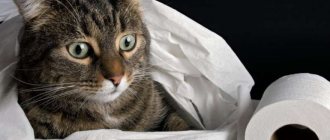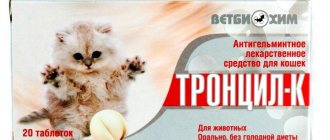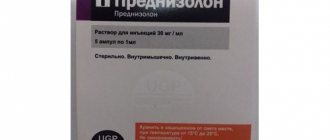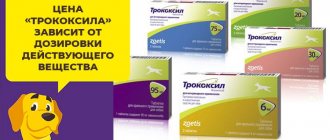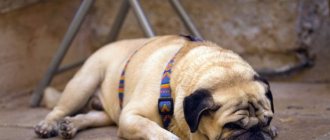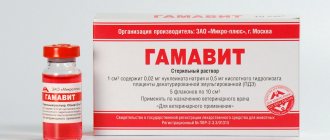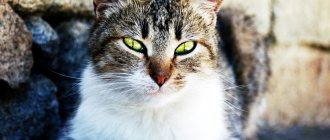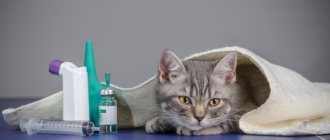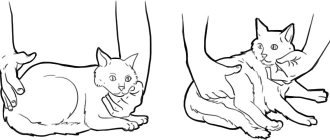12540Pavel
Smecta is rightfully considered one of the most effective drugs that helps a person cope with diarrhea. However, for the felines he became an equally loyal friend. The main thing is to learn how to correctly calculate the dosage. Moreover, you can understand how to give Smecta to a cat by carefully reading just one article. Intestinal upset is not a rare disease for your beloved pet. There is always a reason for diarrhea. It could be something unsuitable for food, obtained on the street, or a stolen piece from the table. In any case, Smecta will be the salvation.
Release form and composition
Smecta is an antidiarrheal drug with an adsorbing effect. The product is available in the form of a sachet with powder, which has a color from grayish-white to grayish-yellow with a faint odor. Produced with orange and vanilla scent.
The composition of 1 sachet of medication includes dioctahedral smectite in a dosage of 3 g. The auxiliary components are dextrose monohydrate, saccharin, and vanilla or orange flavorings, depending on the type of drug.
Sachets are enclosed in a cardboard box of 10 or 30 units.
What you need to know about Smecta
There is a whole group of medicines that belong to sorbents. Such drugs have a universal effect. They can provide effective assistance for almost any disease of the gastrointestinal tract. Smecta is rightfully considered one of the most popular and effective drugs. The medicine instantly absorbs all the excess that is in the stomach and causes discomfort. It successfully copes with viruses, toxins, bacteria, and when treating a cat with Smecta, the effect will be no less impressive than when a person takes the drug.
© shutterstock
The popular medicine contains dioctahedral smectite. It is the active component of the drug. It is a mixture of aluminum and magnesium silicates that have undergone specific processing. As a result, the unique crystalline structure of the compound provided the ability to envelop toxins and pathogenic viruses, eliminating them along with feces. At the same time, Smecta does not have a negative effect on the content of minerals or beneficial intestinal flora.
Causes of diarrhea
The digestive system of our gentle meowing pets is very delicate. Experienced cat breeders who always keep Smecta on hand will say with confidence that intestinal upset in animals is quite common and there can be many reasons for this .
- Eating raw liver.
- Eating spoiled foods.
- Drinking milk due to lactose intolerance.
- Disease of the kidneys, pancreas or liver.
Often, even simple overeating can cause diarrhea in a cat. Fluffy extortionists know how to beg for the tastiest morsels from the table. However, many foods are simply not digestible in the animal’s body. That is why the owner is obliged to monitor the pet’s diet, which should not be harmful to the cat.
Indications
Smecta is prescribed to animals for the treatment of diarrhea of an allergic, drug-induced or infectious nature in acute and chronic form to remove toxic compounds. Helps cope with diarrhea associated with poor diet, introduction of new foods, and poisoning.
It is included in the treatment of other pathologies as a drug to eliminate the symptoms of heartburn, flatulence, discomfort in the digestive tract and other signs that accompany gastrointestinal pathologies.
How to properly treat a cat
The dosage of Smecta for diarrhea and other intestinal diseases is prescribed to a cat or dog directly by a veterinarian. However, many experienced breeders often self-medicate. In this case, the dosage of the drug will have to be calculated independently. Smecta is a medicine developed for people. It is packaged in small bags of 3 grams and is a white powder. Recommendations in the instructions for use of Smecta apply exclusively to humans.
Until the breeder contacts a veterinary clinic specialist for advice and receives special recommendations, as an emergency measure, you can take half a bag of Smecta and dissolve the powder in ¼ cup using slightly cooled boiled water. Some pets like the taste of the drug and do not cause any problems when taking it . In this case, you can simply pour the resulting solution into a small bowl and make sure that the cat laps up a sufficient amount of the suspension. You will have to tinker a little with capricious pets.
Mechanism of action
Smecta, thanks to its adsorbing effect, removes toxic compounds formed in the intestines as a result of the activity of viral, bacterial and fungal microorganisms. Helps eliminate allergens and active substances of components that lead to intestinal dysfunction.
The anti-diarrhea drug has an enveloping effect - it creates a thin protective film on the walls of the digestive tract. This helps to cope with severe intoxication and normalize the general condition.
How to breed pellets
The drug is diluted with water (warm, boiled) until the consistency of liquid sour cream is obtained.
If you refuse to take the medicine, Smecta is dissolved in a large amount of water and forcibly injected into the animal’s oral cavity. This will also help prevent dehydration.
Many animals accept the sweetish taste of the drug, and they even like it. Therefore, there are no difficulties in taking the medicine .
The owner’s task is to ensure that the solution is drunk in the required volume. It is necessary to ensure that the animal does not choke while taking the product.
Contraindications
Expert opinion
Dubas Andrey Leonidovich
Leading physician therapist at the veterinary clinic of Dr. Bugaev
Smecta for cats against diarrhea is a fairly harmless drug. It has a minimum number of contraindications, which include:
- increased sensitivity to smectite, as well as auxiliary components and flavorings;
- constipation and intestinal obstruction;
- Glucose-galactose malabsorption is a syndrome of genetic genesis characterized by impaired absorption of monosaccharides in the gastrointestinal tract;
- sucrase-isomaltase deficiency is a malabsorption syndrome in which the absorption of disaccharides is impaired, develops with insufficiency of invertase, an enzyme of the digestive tract, and is hereditary.
Restrictions
The drug has no contraindications. Smecta can be used to treat kittens from one month of age, pregnant and lactating cats. However, if the cat has a tendency to constipation, it is not recommended to give the suspension even with loose stools. The prohibition for taking is intestinal obstruction.
Important!
If, after taking Smecta, the cat has difficulty defecating (constipation), the medicine should be discontinued or, after consultation with a veterinarian, the dosage should be changed.
Can it be given without a doctor's prescription?
The digestive tract of cats is highly sensitive to changes in diet and food, which often leads to diarrhea. To prevent deterioration and dehydration of your pet, immediate action should be taken at the first sign of diarrhea. For this purpose, rehydration solutions and sorbents are administered to the pet.
Smecta is a harmless adsorbent that is used for diarrhea to remove toxins and normalize the functioning of the digestive system. The drug is available without a prescription. Therefore, if a kitten or adult cat develops the first signs of diarrhea and other digestive tract disorders, you should act immediately and give Smecta.
Do not forget that diarrhea may indicate poisoning of the pet or be a symptom of more serious problems, for example, infectious or allergic in nature. In this case, Smecta alone is not enough and you cannot do without the help of a qualified specialist.
If symptoms of diarrhea appear, your pet should be administered Smecta in accordance with its age and consult a veterinarian.
Dosage
You can buy Smecta at any pharmacy. 1 sachet contains 3 g of powder for preparing a suspension. The dosage will depend on the age and weight of the pet. Kittens can be given enterosorbent from 1 month. To prepare the suspension, you need to take 0.5 sachet and 50 ml of water (for adult cats) or ¼ of the contents of a sachet and the same amount of water (for kittens). The solution must be mixed thoroughly until the powder is completely dissolved, then drawn into a syringe. It is more convenient to use small, 2-5 cc syringes.
You need to infuse the medicine after securing your pet with a towel or diaper. This way you can protect yourself from the cat’s sharp claws. For kittens, the volume of the finished medicine for one dose is 2 ml, for adults – 5 ml. You need to pour the solution into the mouth carefully, from the side, then lightly pinch the muzzle and mouth so that the cat cannot spit out the medicine. After 1-3 hours, the procedure should be repeated.
Important!
Taking Smecta does not relieve the owner of the need to take the cat to the veterinarian to determine the cause of the intestinal disorder.
A course of treatment
In most cases, a single use of the medication is sufficient to eliminate gastrointestinal upset. In exceptional cases, the drug is re-administered after a few hours.
The duration and specifics of treatment are determined by the veterinarian.
How to give the drug
Rarely does the administration of the drug occur without problems. More often, assistance is required to hold the animal in a certain position.
Oral administration of Smecta at home is carried out in several stages:
- Half a sachet of medicine is diluted with warm boiled water to the required consistency.
- After thoroughly mixing the drug, pour it into the syringe, then remove the needle.
- If difficulties arise with administering the solution because the cat resists, then the head and paws are fixed by wrapping them in a piece of cloth (for example, a towel).
- It is necessary to give the cat water by inserting a syringe into the side of the mouth, where the small teeth are located.
- After administering the drug, the oral cavity is lightly clamped so that the animal swallows the drug.
No more than 5 ml of solution is allowed to be administered at a time.
Analogs and cost of medicine
The price of the medicine varies depending on the region where it is purchased, as well as on the number of sachets in the box. 10 packages cost approximately 140-170 rubles.
The drug has analogues that have a similar therapeutic effect. The most in demand are the following:
- activated carbon is a sorbent that is prohibited from being used in the treatment of diarrhea in kittens (10 tablets cost 5-10 rubles);
- Neosmectin is a medicine that has the same price as Smecta and is produced in Russia;
- Enterosgel is actively used in the treatment of gastrointestinal disorders in cats (medicine in a volume of 225 g costs between 400-600 rubles);
- Polysorb is prescribed for diarrhea caused by poor nutrition of the animal, poisoning (the price of the product varies between 200-350 rubles).
Expert opinion
Burmistrova Alena Valerievna
Breeder, 7 years experience.
There are other analogues, but the advisability of their use in the treatment of diarrhea in animals is determined only by a doctor.
Description of the drug
Smecta is a medicine of natural origin, developed on the basis of double silicate of aluminum and magnesium. Available in the form of powder (granules) for the preparation of a suspension, which is taken orally.
The finished solution normalizes the condition of the mucous membranes in the gastrointestinal tract, helps to increase the volume of mucus produced, and improves its gastroprotective properties.
When to consult a veterinarian
Diarrhea in a cat is indicated by symptoms such as loose stools, frequent visits to the toilet, and the presence of mucus or mucous inclusions in the stool.
It is recommended to contact a veterinarian if secondary manifestations are observed, including:
- decreased or complete loss of interest in food;
- weight loss;
- vomiting syndrome;
- elevated temperature;
- decreased physical activity of the animal;
- general malaise.
If any of these symptoms are present, urgent medical attention is needed.
Features of digestion in kittens
Every kitten's digestive system faces two major tests. The fact is that a baby is born with a sterile microflora and one of its main tasks is to travel to the mother’s nipple.
As the kitten takes its first sips of rich colostrum, it ingests bacteria that colonize its intestines and help digest its mother's milk. After giving birth, the cat feeds the kittens colostrum for 1–3 days, after which its composition changes.
A kitten separated from its mother, if it survives on artificial feeding, has a distorted intestinal microflora, which leads to frequent digestive problems - constipation and diarrhea.
When the baby turns 1 month old, his digestive system faces a new test - getting used to adult food. Regardless of whether the mother of the kittens eats natural or industrial food, this food is new for the kittens, one might say, unnatural. The microflora intended for digesting milk begins to be partially replaced, and the intestines become irritated. The kitten begins to have looser stools or diarrhea, indicating that the intestines are protecting themselves by producing more mucus. If the kitten is healthy, then in 2 months (plus or minus a week) its digestion will return to normal.
There is also a risk. Diarrhea quickly leads to dehydration , and when it comes to a kitten, the period is reduced to 20–30 hours. If the cause of diarrhea is not a change in diet, and the baby is not helped, then his condition will greatly worsen. Dehydration leads to blood thickening, which has a detrimental effect on all vital systems.
